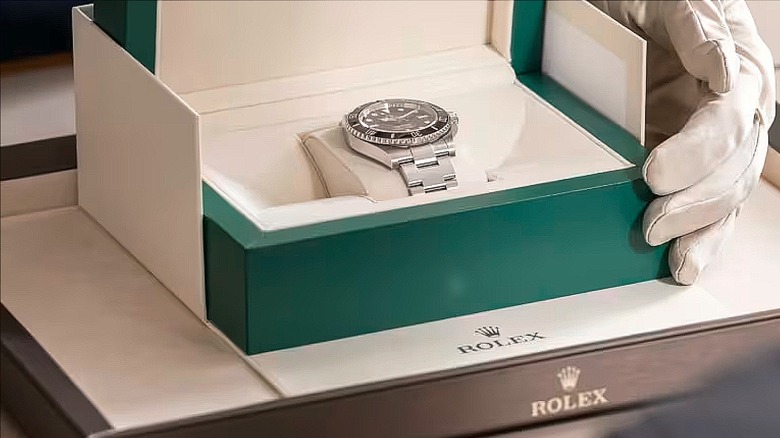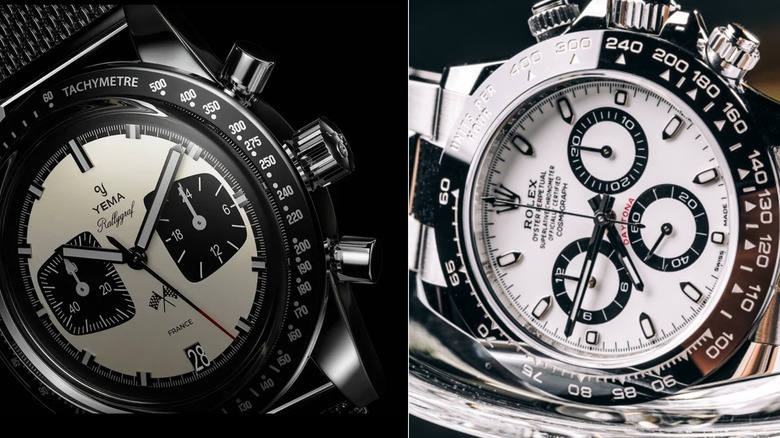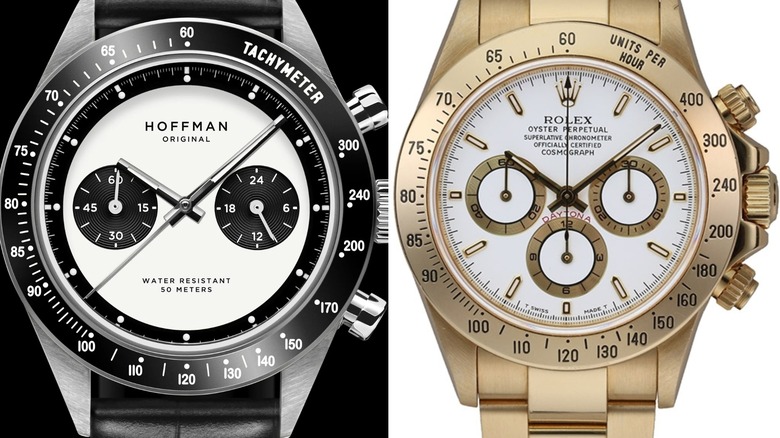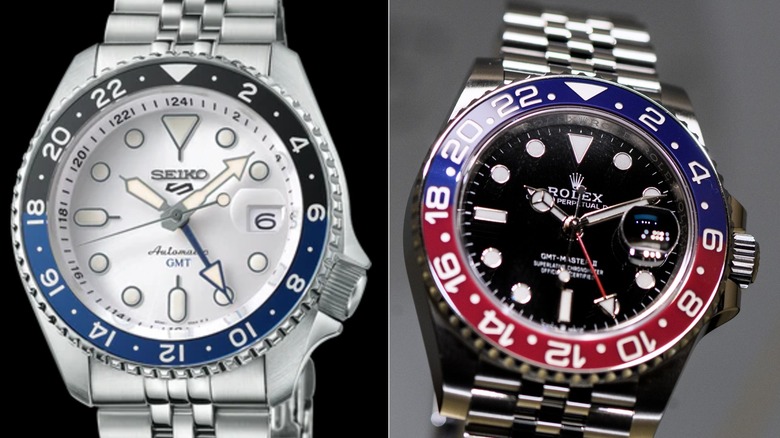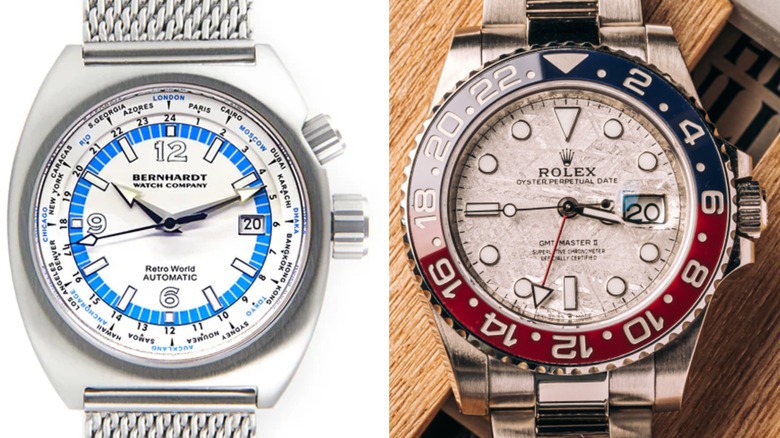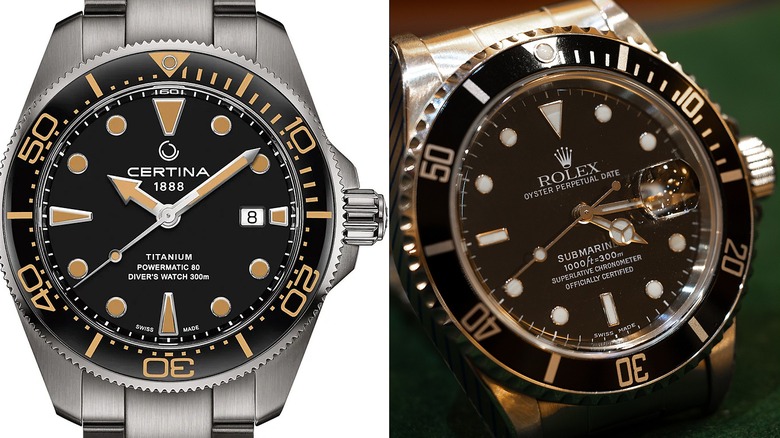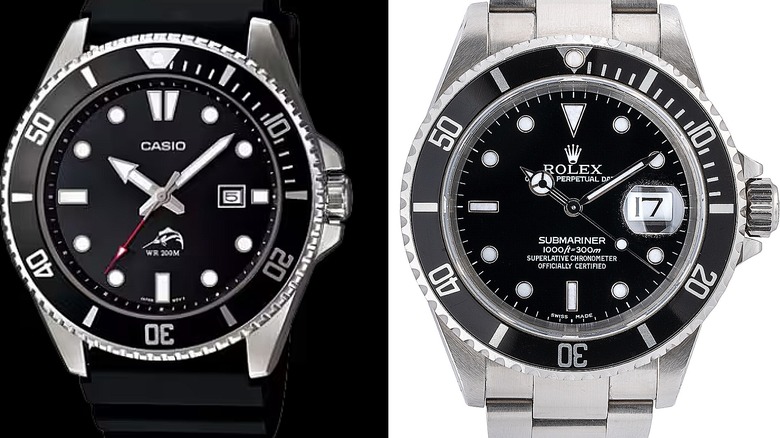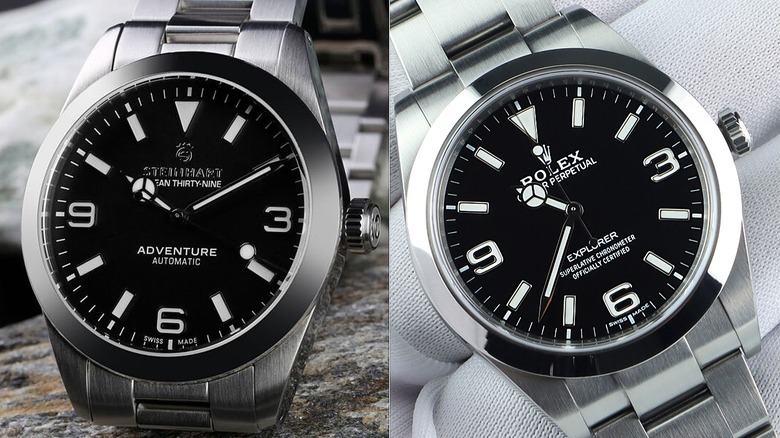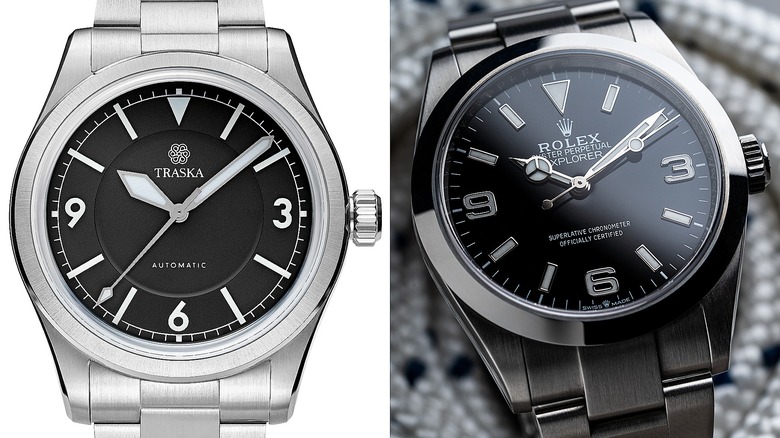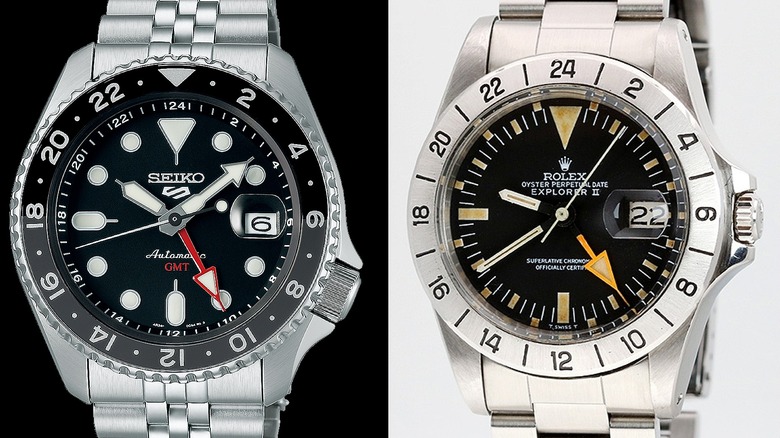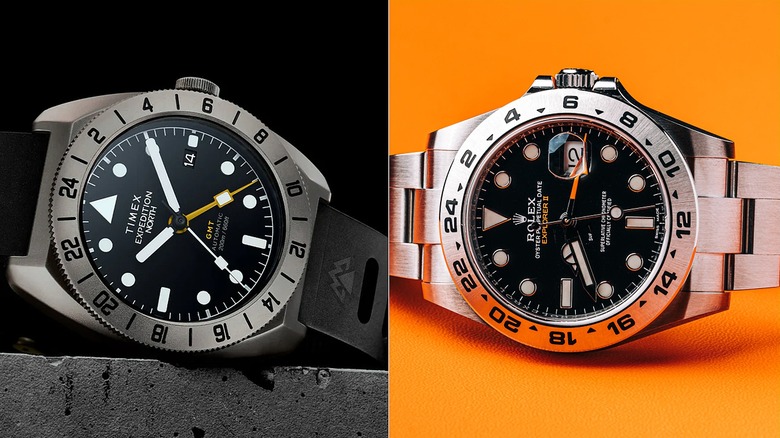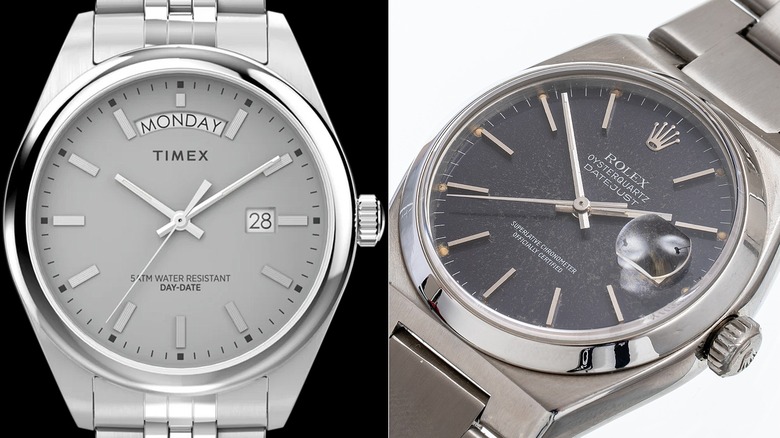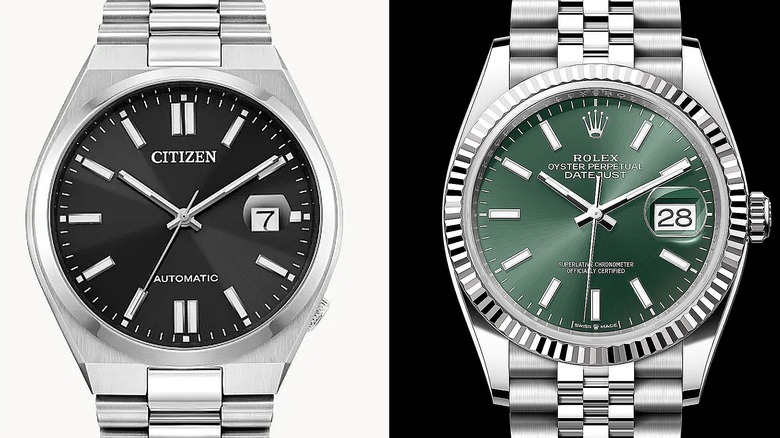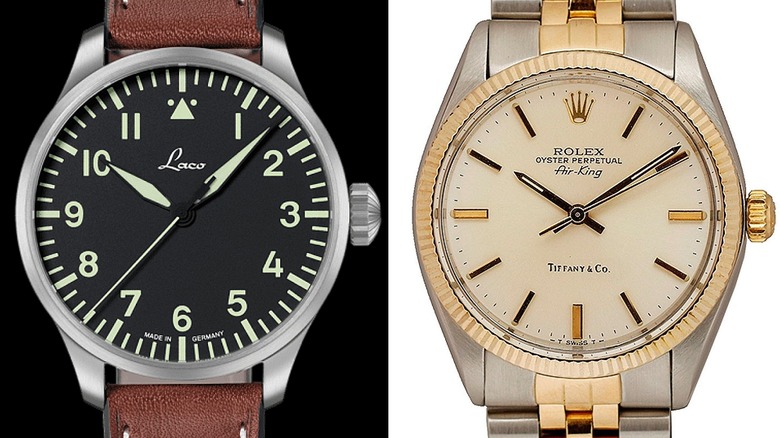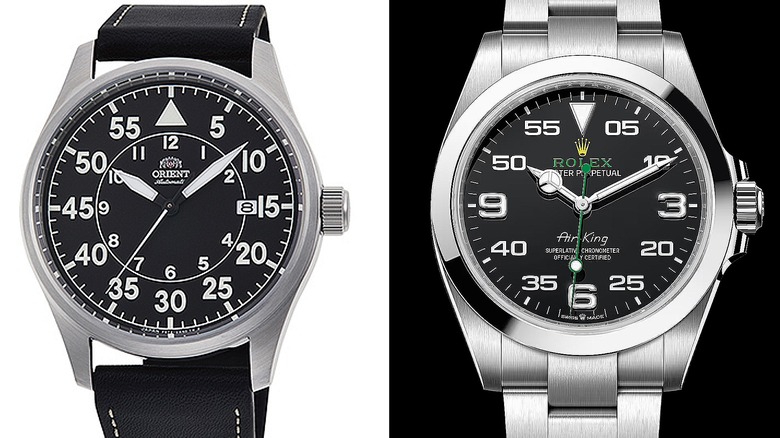The 14 Best Rolex Watch Alternatives That Won't Break The Bank
We may receive a commission on purchases made from links.
Forget the shady character on the corner with the "genuine Rolex" he's willing to sell at a bargain. Save your money and purchase a legitimate Rolex-inspired timepiece from a reputable company that stands behind its products. There's a long (and growing) list of choices for functional and affordable Rolex alternatives, so you don't have to meet the average income of people who own a Rolex watch to have a good-looking timepiece around your wrist.
Even if you're a somewhat new watch enthusiast, you'll have no trouble recognizing such names as Seiko and Timex. You'll also learn the names of lesser-known watchmakers. Some of these have a long history, such as Certina and Laco. Others are 21st-century companies like Bernhardt and Traska. Regardless of their heritage, the names on this list are known for making excellent timepieces. For each of the seven Rolex models featured, Money Digest spotlights two attractive and reliable alternatives.
Rallygraf Meca-Quartz Panda vs Rolex Daytona
The $25,000 Rolex Daytona is immediately identifiable by its dial which bears a strong resemblance to the face of a panda and gives the watch its nickname. Yema captures the spirit of the legendary race car sports watch without copying the Daytona detail for detail. For example, the $420 Yema Rallygraf Meca-Quartz Panda replaces the predictable round panda eyes for its chronographic complications with matching trapezoids.
The Daytona, which is capable of 72 hours of power reserve, uses a proprietary Rolex automatic movement for all its time and chronograph features. On the other hand, the Yema watch uses both automatic and quartz movements. A quartz caliber is responsible for the hour and minute hands, while an automatic mechanism powers the chronograph's racing functions. Early Daytona models, in keeping with the style of the era, had a case measuring only 37 millimeters. In the 1980s, the case grew to 40 millimeters. The Rallygraf measures 39 millimeters in diameter and offers 100 meters or 330 feet of water resistance, the same as the Daytona.
Hoffman Panda vs Rolex Daytona
The Daytona exclusively uses a mechanical movement. However, Hoffman, a young American company, offers its Panda with a Seiko VK64 quartz time movement for $249. If you prefer a mechanical movement for your time function, it's available from Hoffman for $599. For both the quartz and mechanical watches, the Panda uses a vintage mechanical approach for operating the chronographic features. Both versions of this Daytona alternative sport their racing bona fides with tachymeter bezels.
Hoffman's watch includes two subregisters, compared to the Daytona's three. Hoffman includes subdials for hours and minutes, but not seconds. The difference is only significant if you intend to use the Hoffman to time demanding high-speed professional motorsports.
The Hoffman Panda wears similar to the Daytona on the wrist, matching the Rolex in case diameter at 40 millimeters. If you're going to spend much time near water, note that the Panda's water resistance peaks at 50 meters, offering only half the protection of the $25,000 Daytona. In practice, that means you should limit the Hoffman Panda to only incidental contact with moisture, not using it as you would a dive watch.
Seiko 5 Sports SSK033 vs Rolex GMT Master II
The $25,000 GMT II uses non-numerical indices and a three-o'clock date display under magnification from the Rolex-developed Cyclops lens. However, for much less, you can have an automatic alternative GMT Master II watch that looks like the more relaxed, casual version of the Rolex. For example, the Seiko 5 Sports SSK033 also has non-numerical indices but softens their edges with rounded corners. The Seiko's case size is more modern, too, checking in at 42.5 millimeters, compared to the 40-millimeter Rolex.
Like other international date watches, the Seiko model allows for tracking time in two time zones. However, the updated 1982 GMT Master II introduced an additional hand that allows for monitoring time in a third time zone.
The $475 Seiko SSK033 sports a two-toned bezel similar to the Rolex. You can choose the red-blue combination or the blue-black combo. Also, like the Rolex, the Seiko case promises water resistance for 100 meters. Both watches have a date window at three-o'clock, but the crown on the Seiko is between three and four o'clock, while the GMT Master II has the crown at the traditional three o'clock position.
Bernhardt Retro World vs Rolex GMT Master II
Early pilots traveling between time zones could keep track of the hour with watches like the original 1955 GMT Master that marked the time in two time zones using its rotating external bezel. Modern Rolex GMT designs include an additional hand for monitoring time in a third time zone that the Bernhardt does not include. The Bernhardt Watch Company's $429 Retro World uses a rotating bezel for the same purpose of marking multiple time zones but makes its bezel internal rather than external.
The Bernhardt bezel adds the names of the world's major cities positioned appropriately, so, for example, "London" appears five hours ahead of "New York." A total of 24 cities are listed at one-hour increments. The addition of the city names makes the Bernhardt bezel busier than the Rolex bezel, but the clever use of space keeps the names legible. The Bernhardt dial also embraces color while the traditional Rolex dial stays neutral.
Like the Rolex, the Bernhardt has a three o'clock date window and relies on an automatic mechanical movement. The Bernhardt case diameter is 41 millimeters, one millimeter larger than the Rolex. As an added feature, it has an exhibition caseback with the silhouettes of jets crisscrossing the continents.
Certina DS Action Diver vs Rolex Submariner
Both Certina and Rolex have histories of producing timepieces engineered to perform in demanding conditions. For example, under its old name, Grana, Certina built some of the most highly respected of the military watches made for the British during World War II. Then, a few years later, Rolex became the first to offer 100 meters or 330 feet of water resistance in 1953. Improvements followed quickly, allowing the 1954 Rolex model to boast water resistance of 200 meters or 660 feet.
Likewise, Certina continued to increase the performance of its watch cases. Since 1960, the "DS" in the Certina DS Action Diver name has meant "Double Security," referring to the watch's two levels of protection that create water resistance and a cushion for absorbing shocks.
Since 1989, the Submariner has been water resistant for 300 meters or 1,000 feet. The modern Certina also gives you 300 meters of water resistance to match that of the Submariner, but while a new Rolex Submariner will cost you somewhere between $8,000 and $20,000, the Certina DS Action Diver is less than $850 for a 38-millimeter case and $1000 for a 43-millimeter case.
Casio Duro MDV106 vs Rolex Submariner
The Casio Duro MDV106 shows that this brand knows how to deliver an affordable watch without compromising quality. The Duro uses the same indices as the Submariner, but adds the logo of a marlin above the six o'clock position. The marlin appears on Casio MDV series 106 watches that have better than average water protection. Please note that in some parts of the world, the logo is not used on more recent versions, regardless of their waterproof performance. For less than $100, you won't get 300 meters of water resistance as you would with the Rolex, but you'll still receive an impressive 200 meters (656 feet) of water protection. If you do intend to use the Casio while diving, it includes a rotating bezel like Rolex to help you keep track of your time underwater.
Rolex markets its underlying 3230 caliber as capable of keeping the Submariner within plus or minus two seconds per day. Current models also provide an impressive 70 hours of power reserve. The $85 Casio MDV106 uses a quartz movement accurate within plus or minus 20 seconds per month, while lasting three years before needing a new battery. The Duro case measures 44 millimeters, while the Submariner case measures 41 millimeters.
Steinhart Ocean 39 vs Rolex Explorer
While it has become a grail tool watch, the Explorer has also maintained a distinctly elegant design, notable for its prominent three, six, and eight Arabic numerals among its other rectangular indices. There's no escaping the similarity between the 21st-century Steinhart Ocean 39 from Germany and the legendary Rolex Explorer when you compare the indices. The Steinhart even mimics the hour hands of the Explorer, both emblazoned with a Mercedes Benz-like insignia. The Ocean 39 also matches the Explorer in water protection with resistance up to 100 meters (328 feet).
The Steinhart watch uses a Swiss-made automatic movement. As its name implies, the Ocean 39 uses a case measuring 39 millimeters, larger than the original Explorer, which measured 36 millimeters, but still smaller than today's sports watches like the 40-millimeter contemporary Explorer. As a Rolex Explorer alternative, the Ocean 39 is a bargain for only a little more than $600. In contrast, Rolex dealers list the Explorer from $5,000 to $14,000.
Traska Summiteer 38 vs Rolex Explorer
Traska's watch remains true to the simplicity of the Rolex Explorer design. Specifically, it gets its inspiration from an early model of the Explorer from the 1950s. For example, it's only 38.5 millimeters wide, which is just outside the ballpark for the upper size limit of men's watches from that era. But Traska, an American micro-brand, manages to update its $680 Summiteer to keep it from looking like it belongs in a museum rather than on your wrist. it's also far more scratch resistant than vintage watches, using the company's proprietary hardening method to give the case six times more protection than normal steel.
Rolex also has its own method for producing extra strong cases, helping the Explorer earn a reputation as the preferred tough outdoor adventure watch. Appropriately, Rolex houses the Explorer's movement in a 40-millimeter patented Rolex Oyster case that the company guarantees will offer the watch protection from water to a depth of 100 meters. The Summiteer also comes with 100 meters (328 feet) of water resistance.
Seiko 5 SSK001 vs Rolex Explorer II
The Explorer II made its debut in 1971 with a 24-hour bezel so wearers could quickly determine if it were 12 noon or midnight when they were in situations preventing them from viewing the sky. Like the Rolex, the Seiko includes a 24-hour bezel plus a magnified date window at the three o'clock position. But it's not an exact copy of the Explorer II. For instance, it uses circular and oval shapes for indices while Rolex favors stick indices. The stick indices in the Explorer II represented a change for Rolex which used Arabic markers at the three, six, and nine o'clock positions for the original Explorer.
Rolex treats its dial markers with strong luminescent material to make the watch readable under extremely dark conditions. Don't expect the Seiko to have the same degree of luminescence as the Rolex model. However, the $495 Seiko SSK001 does boast the same 100 meters (328 feet) of water resistance as the Explorer II, which is priced from $7,000 to $24,000.
Timex Expedition GMT Titanium Automatic vs Rolex Explorer II
Showing a strong Rolex influence, the Timex Expedition uses only shapes for its indices and places a date window at three o'clock. The Timex indices are bathed in Super Lumi-Nova. It can't match the luminescence of the Rolex proprietary Chromalight material, but it performs well for its price.
The inspiration for this 41-millimeter Timex is undeniably the Explorer II, but Timex infuses its design with various touches to create something better than a discount copycat, all for less than $600. For starters, Timex outdoes Rolex by guaranteeing water resistance of 200 meters (656 feet) rather than the Explorer II's 100 meters (328 feet(. It also flexes with an exhibition caseback. The Explorer II has a case measuring 42 millimeters made from a type of steel Rolex developed that gives its watches the ability to resist corrosion even under brutal conditions. The Timex Expedition, priced at $599, forgoes steel in favor of grade 2 titanium.
Timex Legacy Day and Date vs Rolex Datejust
The Datejust, the legendary dress watch by Rolex, will set you back around $6,000 for a bare-bones edition. Upgrade the features, and you could be talking about $30,000 or more. However, if you're interested in a Datejust alternative, the stainless steel Timex Legacy with a quartz movement is available for under $200. Rolex gives you several ways to customize your Datejust. For example, you can choose your preferred indices, such as Arabic numerals, Roman numerals, or shapes.
At its price, Timex can't offer the same customization as Rolex. Instead, Timex opted to design the Legacy strictly using non-numerical indices. Like the Rolex, the Legacy has a date window at the three o'clock position. Unlike the Rolex, Timex adds the day of the week, positioning it at 12 o'clock with the window large enough to accommodate the entire spelling of the day. The Legacy's 41-millimeter case and mineral crystal give you only 50 meters (164 feet) of water resistance compared to the Datejust's 100 meters (328 feet), so don't take it surfing.
Citizen Tsuyosa Automatic vs Rolex Datejust
Seiko and Casio aren't the only Japanese companies offering Rolex alternatives. Citizen is the sometimes overlooked Japanese watchmaker that produces timepieces that can compete well with more expensive Swiss brands. For example, for less than $400, the Citizen Tsuyosa Automatic gives you the familiar Rolex rectangular hands and magnified date window. While you can order the Datejust with varying dials, the Citizen comes only with non-numeric indices. The date is in the predictable three o'clock position, as is the crown.
With the Citizen, you won't get a Rolex-like 100 meters (328 feet) of water resistance, but only 50 meters (164 feet) of protection. In terms of real-world performance, that means you're okay if you're playing near your pool, but don't take the Citizen deep-sea diving. The Tsuyosa is fully automatic, like the Rolex, remaining wound by the casual movement of your arm. The Datejust is available in 36-millimeter and 41-millimeter cases, while the Tsuyosa uses a stainless steel case measuring 40 millimeters in diameter.
Laco Pilot Watch Basic Augsburg vs Rolex Air-King
The $7,750 Rolex Air-King is the company's nod to British World War II pilots who wore Rolex watches. Pilots, especially fighter pilots, couldn't afford to be distracted by hard-to-read watch dials, so the Air-King is noted for its uncluttered design. The modern Air-King is available with either Arabic numerals or geometric shapes for indices. Laco uses large Arabic numerals to make its dials as legible as the Air-King's. Laco also follows the Rolex design approach by avoiding unnecessary complications, such as a date window.
The Air-King runs on a movement Rolex developed for its own use. Similarly, the 39-millimeter and 42-millimeter pilot watches from Laco are available with movements built in-house. The Laco watches can't match Air-King's 100 meters (328 feet) of water resistance, protecting the watch for only 50 meters (164 feet), but that's not bad for a legitimate Air-King watch alternative as long as you leave it poolside. This clean, modern-day take on 20th-century pilot watches by Laco will only cost you between $410 and $460.
Orient RN-AC0H03B Flight vs Rolex Air-King
Modern Air-King models have black dials with large, white numerical indices. But it isn't just the usual three, six, and nine that are oversized. The minute markers, also in Arabic numerals, are some of the biggest you're likely to see on a professional watch. Orient's $200 watch echoes the Air-King's design with unusually large Arabic numeral minute markers historically accurate for use as a pilot's watch. The Orient Flight marks the minutes on an outer ring and the hours on an inner ring. The Orient also includes a small date window at the three o'clock position.
The 100-meter (328-foot) water-resistant stainless steel Orient case is 42.4 millimeters in diameter versus the 40 millimeters of the Rolex. The Orient Flight is capable of about 40 hours of power reserve. Typically, an homage watch at a discount price raises concerns. However, in this case, the maker is Orient, a well-respected Japanese brand even among watch enthusiasts.
